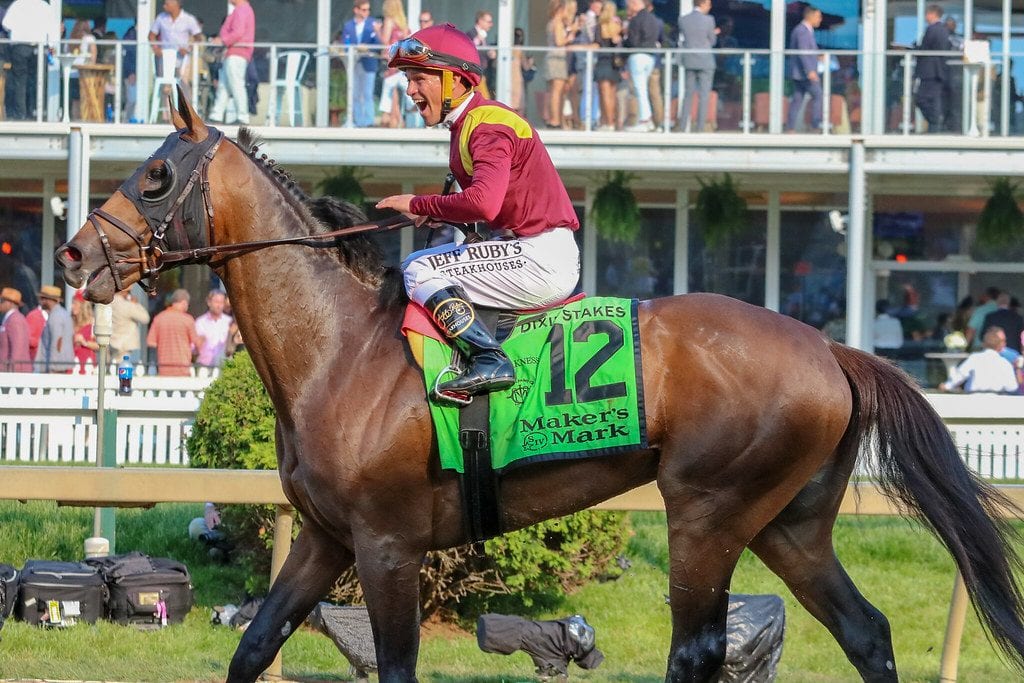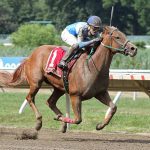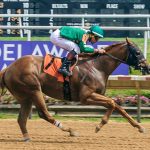DINNER PARTY STAKES has LONG, WINDING HISTORY

This year, Pimlico Race Course celebrates its 150th year on the precipice of another phase of its life, as Baltimore anticipates a new Pimlico to rise from the footprint of the old one in the next few years.
Built on 70 acres in an area English settlers named after a tavern back in the old country, Pimlico has been home to two signature stakes races, one that has been part of the crowning of thirteen immortals and the other a race named for the very soiree that gave rise to Old Hilltop. On a balmy summer evening in Saratoga came the inspiration for both Pimlico Race Course and its oldest stakes race, the Dinner Party Stakes.
On August 6, 1868, famed English-born jockey Billy Hayward piloted Lancaster to victory in the fourth Saratoga Cup. Lancaster’s win in the 2 ¼ mile race brought $1,000 for his owner Milton Sanford, a Massachusetts textile mill owner whose wealth had come from supplying the Union Army with blankets during the recent Civil War. For Sanford’s friends, it brought a celebration, a dinner party attended by such luminaries as John Hunter, one of Saratoga Race Course’s founders, and Oden Bowie, governor of Maryland.
As legend goes, their celebratory mood gave rise to an idea, as good liquor and great company can do: commemorate their legendary evening with a horse race, of course, two years hence, when their present yearlings would be three years old. Both Hunter and Bowie embraced the idea whole-heartedly, offering to host the event in their respective states. Though Hunter and Saratoga offered their excellent facilities for the race, Bowie one-upped him, vowing to build a brand new racetrack and award a purse of $15,000 for that race if Maryland could host the event. Thus the Dinner Party Stakes was born.
Two years later, on October 25, 1870, eight horses met the barrier for the two-mile Dinner Party Stakes. Included in the field were four horses sired by Lexington, one of America’s foundation sires; among those was the colt Preakness, owned by Milton Sanford. Preakness took the lead in the stretch, beating My Maryland and Finesse to the wire, and bringing home $19,000 to Sanford, the host of that fateful dinner party. Three years later, Bowie would name a new stakes race for Preakness, inaugurating what we now know was the middle jewel of the Triple Crown, the Preakness Stakes.
While most racing fans will know the roster of famous names that have called the Preakness theirs, the Dinner Party Stakes boasts as many renowned winners in its 150 years as part of the mid-Atlantic’s racing calendar.
- Spa selections 2024: Saratoga picks July 27

 Picks and analysis for today’s key races from Saratoga.
Picks and analysis for today’s key races from Saratoga.
SIGNATURE WINNERS
Preakness made history as the horse that opened Pimlico’s first season of racing with his win in the Dinner Party Stakes in 1870, but his is not the only illustrious name to win this race. In 1871, the Dinner Party became the Reunion Stakes, still a two-mile race for three-year-olds. Belmont and Travers Stakes winner Harry Bassett won the Reunion in a walkover, adding it to his long list of victories that year. The race was renewed for 1872 as the Dixie Stakes, retaining the conditions of both the Dinner Party and the Reunion Stakes. The race stayed at Pimlico until 1889, with horses like Hanover, Duke of Magenta, and Tom Ochiltree among its winners.
Pimlico did not hold a meet from 1889 to 1904, so the Dixie Stakes was on hiatus until it was revived at Benning Race Track near Washington, D.C. from 1902-1907. The race took another hiatus until 1915, when the Dixie Stakes returned to its original home, this time at 1 3/16 miles. From 1919 to 1922, the race again was absent from Pimlico’s list of stakes races, but returned for good in 1924 with the name Dixie Handicap, rather than Stakes. Again, the Dixie was 1 3/16 miles, but would be run at a variety of distances between 1924 and 2020, from as long as 1 5/8 miles to its present 1 1/16 miles. In 1955, the Dixie Handicap switched from dirt to turf, where it remains a grass feature at Pimlico to this day. Though the race has moved around on Pimlico’s calendar throughout its history, the race is now a Grade II feature on the Preakness undercard.
Whether on turf or dirt, the Dixie continued its tradition of famed horses winning Pimlico’s oldest stake. Sarazen, twice a retroactive Horse of the Year, won the Dixie in 1925 and 1926. Legendary handicapper of the 1930s Equipoise won in 1934. Triple Crown winners Whirlaway and Assault both were victorious in the Dixie as four-year-olds. Later, after the race moved to the turf, horses like Fort Marcy, 1970 Horse of the Year; Lure, two-time winner of the Breeder’s Cup Mile; and Catholic Boy, 2018 Travers Stakes winner, all brought home victories in the Dixie.
For 2020, the field includes Somelikeithotbrown, winner of the Bernard Baruch Stakes and the Jeff Ruby Steaks, and Factor This, winner of the Grade 2 Wise Dan Stakes. Factor This is the even-money favorite off a runner-up effort in the Grade 1 Turf Classic on Derby day at Churchill Downs.
- Dontlookbackatall hopes to see way to G3 Caress win

 Pennsylvania-bred Dontlookbackatall hopes to stretch her win streak to three in Thursday’s G3 Caress at the Spa in a race with a serious Midlantic flavor.
Pennsylvania-bred Dontlookbackatall hopes to stretch her win streak to three in Thursday’s G3 Caress at the Spa in a race with a serious Midlantic flavor.
A NEW ERA DAWNS
The COVID-19 pandemic necessitated a change to Pimlico’s schedule for 2020, moving its signature stakes races like the Black-Eyed Susan and the Preakness Stakes to Saturday, October 3rd.
In addition, the nationwide civil unrest has shone a spotlight on issues of systemic racism. That led the Maryland Jockey Club to scrap the traditional playing of Maryland, My Maryland — an anthem written to promote secession — before the Preakness and ditch the “Dixie” moniker for its oldest stakes race.
Instead, the Dixie Stakes/Handicap has made a return to its original name, the Dinner Party Stakes, just in time to celebrate the track’s 150th anniversary. As the race that opened Pimlico’s doors a century and a half ago, this celebrated stake’s return to its roots brings racing fans back to where the traditions of mid-Atlantic racing began, a chance to celebrate once again that Saratoga soiree that gave rise to one of America’s great racetracks. This Saturday, Maryland will celebrate once again these racing traditions that are so much a part of the region’s long history with the sport of kings, another great day of fast horses and fabulous stories.
FOR MORE INFO
- Dixie Stakes: https://en.wikipedia.org/wiki/Dixie_Stakes
- Preakness Stakes: https://en.wikipedia.org/wiki/Preakness_Stakes
- Benning Race Track: https://en.wikipedia.org/wiki/Benning_Race_Track
- https://ggwash.org/view/4055/lost-washington-benning-race-track
- https://offbeatenpathdc.com/benning-race-track/
- https://www.washingtonpost.com/blogs/all-opinions-are-local/wp/2016/05/19/remembering-bennings-race-track/
- Saratoga Cup: https://en.wikipedia.org/wiki/Saratoga_Cup
- Milton Sanford: https://en.wikipedia.org/wiki/Milton_H.Sanford
- Preakness Stud: https://en.wikipedia.org/wiki/Preakness_Stud
- Lexington: https://en.wikipedia.org/wiki/Lexington(horse)
- http://www.americanclassicpedigrees.com/lexington.html
- Pimlico Race Course: https://en.wikipedia.org/wiki/Pimlico_Race_Course
- https://explore.baltimoreheritage.org/items/show/492
- https://www.preservationmaryland.org/history-preakness-pimlico-baltimore/
- https://www.baltimoresun.com/bal-pimlicohistoryapr29-story.html
- https://www.pimlico.com/about/history
- Pleasures of the turf (1877 Dixie recap): https://timesmachine.nytimes.com/timesmachine/1877/10/24/81711411.pdf
- Dinner Party Stakes: https://www.horseracingnation.com/race/2020_Dinner_Party_Stakes#
- The ‘lost’ Preaknesses: https://www.baltimoresun.com/news/bs-xpm-2006-05-20-0605200159-story.html
- William Hayward: https://www.newspapers.com/clip/15211111/william-hayward-jockey-april-12-1909/
- Saratoga: https://www.saratogaracetrack.com/about/history-saratoga-race-course/
LATEST NEWS














